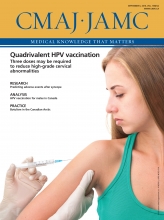Clinical and laboratory assessment is needed to establish a diagnosis of urinary tract infection
There are several approaches to diagnosing urinary tract infection in older adults, with certain common elements in diagnostic criteria. The accepted criteria are two clinical symptoms (from the following list: temperature > 38°C, urinary urgency or frequency, acute dysuria, hypogastric pain, costovertebral angle tenderness) and laboratory findings of bacteriuria (> 100 000 colony-forming units/mL) or pyuria (> 10 leukocytes/high-power field).1,2 For patients with cognitive impairment who cannot communicate or who have urinary incontinence at baseline, consensus guidelines may be used (Appendix 1, available at www.cmaj.ca/lookup/suppl/doi:10.1503/cmaj.150708/-/DC1).
The prevalence of asymptomatic bacteriuria and pyuria is high among older adults
Population studies have shown a high prevalence of asymptomatic bacteriuria among older adults living in institutional settings (25%–50% in women, 15%–35% in men).1–3 Nearly 90% of institutional residents have pyuria without symptoms specific to urinary tract infection.1–3 Findings of bacteriuria or pyuria alone are insufficient to diagnose urinary tract infection; clinical symptoms must also be present.
Urine dipstick testing can be used to exclude urinary tract infection
The negative predictive value of dipstick testing for leukocyte esterase and nitrites is close to 100%. This method, rather than urinalysis or urine culture, can be used to effectively rule out urinary tract infection.4
There are risks associated with treating asymptomatic bacteriuria
One prospective randomized trial comparing antibiotic therapy with no therapy for asymptomatic bacteriuria showed no long-term difference in the incidence of symptomatic urinary tract infection, no improvement in survival and no changes in chronic symptoms.5 The same trial showed an increase in adverse effects from antibiotic therapies, including antibiotic resistance and drug–drug interactions,5 which emphasizes the need for antibiotic stewardship.
Altered mental status in patients with suspected urinary tract infection should prompt further investigation
If a resident’s mental status changes, an evaluation, guided by history and symptoms, should be undertaken. Recent medication changes must be evaluated as potential contributors to altered mental status. If the symptoms are not specific to the urinary tract, other causes should be ruled out before testing for urinary tract infection.
CMAJ invites submissions to “Five things to know about …” Submit manuscripts online at http://mc.manuscriptcentral.com/cmaj
Footnotes
Competing interests: None declared.
This article has been peer reviewed.











